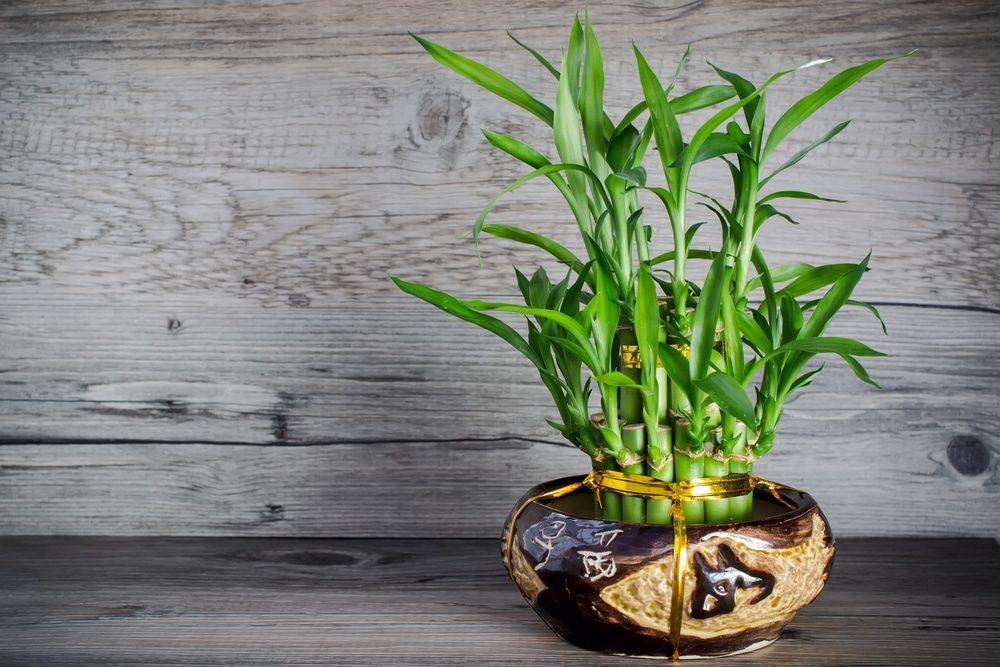- No products in the cart.
In recent years, Lucky Bamboo (Dracaena sanderiana) has surged in popularity, valued not only for its ornamental allure but also for its perceived auspicious qualities in Chinese culture. According to Feng Shui principles, the placement of Lucky Bamboo is believed to usher in prosperity to its surroundings. Its distinctive appearance and adaptability to water cultivation make it an excellent option for both indoor gardening and decorative purposes.
This article will walk you through crucial aspects of planting, growing, and maintaining your lucky bamboo, covering propagation, potting techniques, and potential challenges to be mindful of.
Lucky Bamboo Care
Lucky bamboo, a favored indoor plant, is thought to usher in good luck and positive vibes to any space. Known for its resilience and minimal care requirements, it’s the perfect green companion for those with hectic schedules looking to introduce a touch of nature into their living or working spaces. Beyond its aesthetic appeal and ease of maintenance, lucky bamboo holds cultural significance as a symbol of prosperity and good fortune.
Now, let’s delve into key care tips to ensure your lucky bamboo thrives.
Light
Lucky bamboo thrives in moderate to low light conditions, with variations in light requirements among different bamboo types. Variegated varieties, for instance, may need more light compared to their solid green counterparts.
If you observe stunted growth or yellowing leaves, it signals insufficient light, while browning or scorched leaves indicate potential overexposure to direct sunlight. However, lucky bamboo generally tolerates low light better than excessive light.
To gauge light adequacy, observe the plant’s growth patterns. Lucky bamboo naturally leans towards its light source. If you notice a noticeable tilt in one direction, consider rotating or relocating it for balanced exposure.

Soil
While lucky bamboo typically thrives without soil, some individuals choose to cultivate it in soil for aesthetic appeal or to encourage robust root development. When opting for soil, it’s crucial to select a well-draining mix enriched with organic matter.
To enhance soil drainage, incorporate perlite or sand into the mix. This addition prevents water accumulation around the roots, safeguarding against issues like root rot or fungal diseases.
Additionally, when growing lucky bamboo in soil, consider the pot size. Avoid oversized pots, as they can lead to excessive watering and stagnant soil. Opt for a pot just slightly larger than the root ball to maintain an optimal balance.
Water
Lucky bamboo is primarily grown hydroponically, meaning it thrives in water. If you opt for this method, it’s crucial to change the water every two weeks or more frequently if it becomes murky or develops an unpleasant odor.
During water changes, ensure a thorough rinsing of the roots to eliminate any debris or algae accumulation. For added nourishment, consider incorporating a few drops of liquid fertilizer into the water to stimulate growth and maintain vibrant, green foliage.
If you choose to cultivate lucky bamboo in soil, adopt a weekly watering schedule or more frequently if the top inch of soil feels dry to the touch. Be cautious not to wet the leaves or stem, as this may attract pests or lead to fungal infections.
Use distilled or filtered water for lucky bamboo, particularly if your tap water has chlorine or fluoride, due to its sensitivity. This precaution ensures optimal conditions for the plant’s well-being.
Temperature and Humidity
Lucky bamboo thrives in moderate to warm temperatures and appreciates high humidity. Boost moisture in low-humidity environments by using a humidifier or regularly misting the plant with a spray bottle indoors or in dry climates. Take care to shield the plant from cold drafts, as exposure can lead to yellowing or browning of the leaves. If your lucky bamboo appears unhealthy, it may signal that it’s not within the optimal temperature or humidity range.
How to Propagate Lucky Bamboo?

Propagating Lucky Bamboo is a rewarding and enjoyable venture accessible to everyone, offering a fantastic opportunity to grow your indoor plant collection. Two straightforward methods, namely stem cutting and division, make the process both accessible and adaptable to personal preference. Engaging in the propagation of lucky bamboo not only adds a touch of fun to your gardening activities but also allows you to witness the growth and expansion of your greenery indoors.
Mastering Lucky Bamboo care involves thoughtful attention to light, soil, water, and environmental conditions. Through this care, you not only nurture a symbol of prosperity but also cultivate a thriving and harmonious indoor garden. May your care for Lucky Bamboo bring vibrant greenery and the positive energy and fortune it is known for.
Frequently Asked Questions about How to Care for Lucky Bamboo Plants
Q1. Is direct sunlight necessary for lucky bamboo?
A1. Generally, lucky bamboo plants thrive in partial shade or indirect sunlight under medium to low light conditions.
Q2. Is it better for lucky bamboo to grow in water or soil?
A2. Lucky bamboo can be cultivated in either water or soil, but it tends to have a longer lifespan when grown in well-watered and well-drained soil. Water-grown plants typically survive for about a year, while soil-grown ones can live for a few years.
Q3. Where is the ideal placement for lucky bamboo?
A3. Choose a location away from air conditioning or heating vents, providing good indirect sunlight for optimal growth.


